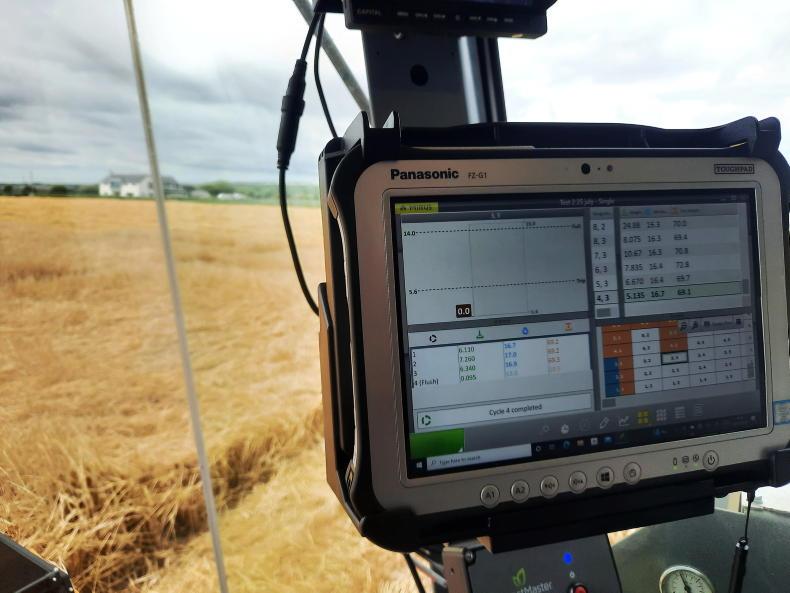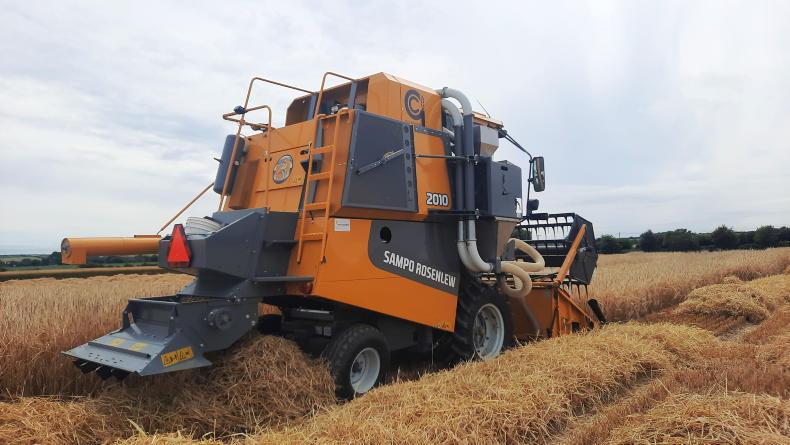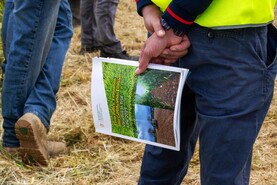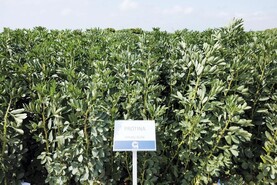A new piece of machinery onto a farm is always exciting.
A combine purchase is one of the rarer purchases on farms. A small combine to cut trial plots is an even rarer purchase in this country.
With just a few of the machines in Ireland, new ones aren’t running up and down fields.
It was a big day when a new Sampo 2010 trial plot combine arrived out of the box to Shanagarry, Co Cork just a few weeks ago and cut its first trial plots last week.
Trials manager
John Dunne is the trials manager with Goldcrop. He manages the company’s trial site, which is on his family’s farm in east Cork. This site is used to test varieties from around the world for suitability to Irish conditions.

John Dunne, cereal variety manager at Goldcrop on his farm with his daughter Isabel. (big enough picture)
Hundreds of plots are grown and tested on the site and examined for disease resistance, yield, grain quality and straw strength.
He was clearly delighted with the new arrival, which has a 2.3m header.
The Finland-made machine is fitted with HarvestMaster trials equipment from the US.

The monitor shows all results and the average result for each plot.
It’s a big change from the previous combine, which isn’t going anywhere it should be added.
Up to last year, a 1984 red Deutz Fahr 2385, retrofitted with a weighing system and later on fitted with a moisture probe, harvested the hundreds of plots which Goldcrop grows each year.
Weighing and testing
At first glance, the combine is like any other. It needs to separate the grain from the straw. It even has a chopper fitted.

The combine has a chopper at the back. The weighing and testing system can be seen on the side.
On this machine though, as the grain goes to the tank, it is weighed, sampled, tested for quality and cleaned. Some farmers will say their yield mapping technology gives them a yield and a moisture, but this machine is on a whole different level. It basically has a grain testing laboratory on board.
The HarvestMaster Grain Gauge has chambers which take in grain and weigh fixed volumes. A moisture test is also carried out at this time, using electrical conductivity, like a moisture metre in a laboratory.
KPH is also calculated during the weighing procedure. Moisture and KPH are calculated three to four times in a 12m long plot and the result is averaged across the plot.
Very importantly, the technology also takes vibrations out of the equation. Combines have shakers and walkers moving which shake the machine and, if not reduced on the weighing system, will affect the accuracy of that weight and measurements taken.
Clean samples
The machine will deliver a sample at the end of each plot if it’s needed. Once the sample bag is in place, it does this automatically. That sample can also be guaranteed to only have come from the last plot harvested.

The machine is cleaned between each plot.
A cleaning system on the combine cleans out the header and the workings of the machine to ensure that all grains in a sample are from the one variety. This is important for accurate testing.
It is a great advantage if the seed from a plot is needed for seed multiplication as the sample will be pure. It also allows samples to be tested for things like malting and ensures grain from other varieties do not make it into small samples.
If larger amounts of seed are needed for multiplication large samples can be collected at the side of the machine from the tank. “The winter barley was sown here in October and you look after it all year and try and get everything growing as best you can.
“If the harvesting part of it lets you down it could be a year’s work gone to waste so its absolutely essential that they’re harvested accurately and the results you get are representative of reality,” John explained.
So far progress is good
“We’re harvesting at low moisture content. Yield is good considering the year that we’ve had. Grain quality is very good. KPHs are high and the machine is doing a nice job so far,” John commented.
Investing in the future
John explained that the smallest difference in yield between one variety and another can result in a potential variety being taken out of the selection process.
“Accuracy is key with this job because you’re looking at small percentage differences between varieties.
Some varieties will make it and many will not, but you need to be able to spot promising ones. A couple of percent either way could make something be missed.”
John said that the significant financial investment is a sign of confidence in the future of the tillage sector.
“It’s a huge investment for Goldcrop and the Murphy family. It’s a family-owned business.
We [Goldcrop] are passionate about Irish farming and we really want to do what we can to ensure the future of Irish agriculture and, in my case specifically, tillage.
“We’re thinking long-term and you have to spend money and invest. It’s a big commitment from Goldcrop. If it turns up as many varieties as the Deutz did, we’ll be very happy,” John added.
You can see a video of the new Sampo working at Goldcrop here.
A new piece of machinery onto a farm is always exciting.
A combine purchase is one of the rarer purchases on farms. A small combine to cut trial plots is an even rarer purchase in this country.
With just a few of the machines in Ireland, new ones aren’t running up and down fields.
It was a big day when a new Sampo 2010 trial plot combine arrived out of the box to Shanagarry, Co Cork just a few weeks ago and cut its first trial plots last week.
Trials manager
John Dunne is the trials manager with Goldcrop. He manages the company’s trial site, which is on his family’s farm in east Cork. This site is used to test varieties from around the world for suitability to Irish conditions.

John Dunne, cereal variety manager at Goldcrop on his farm with his daughter Isabel. (big enough picture)
Hundreds of plots are grown and tested on the site and examined for disease resistance, yield, grain quality and straw strength.
He was clearly delighted with the new arrival, which has a 2.3m header.
The Finland-made machine is fitted with HarvestMaster trials equipment from the US.

The monitor shows all results and the average result for each plot.
It’s a big change from the previous combine, which isn’t going anywhere it should be added.
Up to last year, a 1984 red Deutz Fahr 2385, retrofitted with a weighing system and later on fitted with a moisture probe, harvested the hundreds of plots which Goldcrop grows each year.
Weighing and testing
At first glance, the combine is like any other. It needs to separate the grain from the straw. It even has a chopper fitted.

The combine has a chopper at the back. The weighing and testing system can be seen on the side.
On this machine though, as the grain goes to the tank, it is weighed, sampled, tested for quality and cleaned. Some farmers will say their yield mapping technology gives them a yield and a moisture, but this machine is on a whole different level. It basically has a grain testing laboratory on board.
The HarvestMaster Grain Gauge has chambers which take in grain and weigh fixed volumes. A moisture test is also carried out at this time, using electrical conductivity, like a moisture metre in a laboratory.
KPH is also calculated during the weighing procedure. Moisture and KPH are calculated three to four times in a 12m long plot and the result is averaged across the plot.
Very importantly, the technology also takes vibrations out of the equation. Combines have shakers and walkers moving which shake the machine and, if not reduced on the weighing system, will affect the accuracy of that weight and measurements taken.
Clean samples
The machine will deliver a sample at the end of each plot if it’s needed. Once the sample bag is in place, it does this automatically. That sample can also be guaranteed to only have come from the last plot harvested.

The machine is cleaned between each plot.
A cleaning system on the combine cleans out the header and the workings of the machine to ensure that all grains in a sample are from the one variety. This is important for accurate testing.
It is a great advantage if the seed from a plot is needed for seed multiplication as the sample will be pure. It also allows samples to be tested for things like malting and ensures grain from other varieties do not make it into small samples.
If larger amounts of seed are needed for multiplication large samples can be collected at the side of the machine from the tank. “The winter barley was sown here in October and you look after it all year and try and get everything growing as best you can.
“If the harvesting part of it lets you down it could be a year’s work gone to waste so its absolutely essential that they’re harvested accurately and the results you get are representative of reality,” John explained.
So far progress is good
“We’re harvesting at low moisture content. Yield is good considering the year that we’ve had. Grain quality is very good. KPHs are high and the machine is doing a nice job so far,” John commented.
Investing in the future
John explained that the smallest difference in yield between one variety and another can result in a potential variety being taken out of the selection process.
“Accuracy is key with this job because you’re looking at small percentage differences between varieties.
Some varieties will make it and many will not, but you need to be able to spot promising ones. A couple of percent either way could make something be missed.”
John said that the significant financial investment is a sign of confidence in the future of the tillage sector.
“It’s a huge investment for Goldcrop and the Murphy family. It’s a family-owned business.
We [Goldcrop] are passionate about Irish farming and we really want to do what we can to ensure the future of Irish agriculture and, in my case specifically, tillage.
“We’re thinking long-term and you have to spend money and invest. It’s a big commitment from Goldcrop. If it turns up as many varieties as the Deutz did, we’ll be very happy,” John added.
You can see a video of the new Sampo working at Goldcrop here.










 This is a subscriber-only article
This is a subscriber-only article









SHARING OPTIONS: